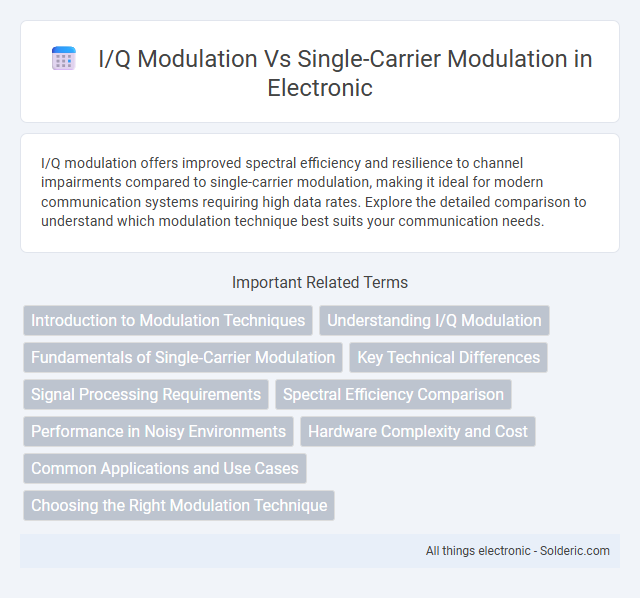I/Q modulation offers improved spectral efficiency and resilience to channel impairments compared to single-carrier modulation, making it ideal for modern communication systems requiring high data rates. Explore the detailed comparison to understand which modulation technique best suits your communication needs.
Comparison Table
| Feature | I/Q Modulation | Single-Carrier Modulation |
|---|---|---|
| Definition | Modulation using in-phase (I) and quadrature (Q) components to encode data. | Modulation using a single carrier signal with data encoded in amplitude or phase. |
| Examples | QAM, QPSK | ASK, FSK, PSK (single carrier) |
| Spectral Efficiency | High spectral efficiency due to simultaneous use of I and Q channels. | Lower spectral efficiency compared to I/Q modulation. |
| Complexity | Higher complexity requiring precise I/Q imbalance correction. | Simpler implementation with fewer hardware requirements. |
| Robustness to Multipath | Less robust, often requires equalization techniques. | More robust in multipath environments. |
| Use Cases | Modern wireless systems (LTE, 5G), high data rate communications. | Legacy systems, low data rate, systems with simpler hardware. |
| Bandwidth Usage | Efficient bandwidth utilization leveraging two orthogonal carriers. | Consumes more bandwidth for similar data rates. |
| Signal Representation | Two-dimensional representation (I and Q axes). | One-dimensional representation on amplitude or phase. |
Introduction to Modulation Techniques
I/Q modulation employs in-phase and quadrature components to encode data, enabling efficient use of bandwidth and improved signal robustness in modern communication systems. Single-carrier modulation transmits data using a single carrier frequency, often resulting in simpler implementation but potentially less spectral efficiency and increased susceptibility to multipath interference. Understanding these fundamental modulation techniques helps optimize your communication system's performance based on channel conditions and system requirements.
Understanding I/Q Modulation
I/Q modulation encodes information by varying the amplitude and phase of two orthogonal signals, the in-phase (I) and quadrature (Q) components, enabling efficient use of bandwidth and improved signal robustness. This method supports advanced modulation schemes like QAM and PSK, which enhance data rates and spectral efficiency compared to single-carrier modulation. The separation of signals into I and Q components allows precise control over signal representation, critical for modern communication systems such as 4G and 5G.
Fundamentals of Single-Carrier Modulation
Single-carrier modulation encodes information onto a single carrier wave by varying its amplitude, frequency, or phase, forming the basis for traditional modulation schemes like Amplitude Modulation (AM) and Frequency Modulation (FM). It transmits one symbol per carrier frequency within each symbol duration, offering simplicity in implementation and resilience to certain types of interference. This modulation is typically characterized by lower bandwidth efficiency compared to I/Q modulation but benefits from reduced complexity in receiver design and signal processing.
Key Technical Differences
I/Q modulation uses two orthogonal carriers to transmit data simultaneously, effectively doubling spectral efficiency compared to single-carrier modulation which transmits data sequentially on one carrier. I/Q modulation enables complex signal constellations such as QAM and PSK, providing higher data rates and improved bandwidth utilization, while single-carrier modulation typically suffers from inter-symbol interference in multipath environments. Your choice depends on system complexity, power efficiency, and channel conditions, as single-carrier modulation offers simpler implementation and robustness, whereas I/Q modulation delivers enhanced spectral efficiency and flexibility in modern communication systems.
Signal Processing Requirements
I/Q modulation demands complex signal processing involving separate in-phase (I) and quadrature (Q) components, enabling efficient bandwidth utilization and robust data transmission in advanced communication systems. Single-carrier modulation requires simpler processing with a single amplitude or phase-varying signal, making it less computationally intensive but more susceptible to inter-symbol interference in multipath environments. Your choice depends on balancing processing capability with performance needs, as I/Q modulation typically necessitates more sophisticated digital signal processing hardware and algorithms.
Spectral Efficiency Comparison
I/Q modulation offers higher spectral efficiency compared to single-carrier modulation by enabling the transmission of two signals simultaneously on the same frequency band through in-phase (I) and quadrature (Q) components. This technique effectively doubles data throughput without requiring additional bandwidth, making it ideal for bandwidth-limited communication systems. Your system can achieve better utilization of spectrum resources by adopting I/Q modulation, especially in complex signaling environments.
Performance in Noisy Environments
I/Q modulation offers superior performance in noisy environments due to its ability to separate signals into in-phase and quadrature components, which improves signal recovery and reduces bit error rates. Single-carrier modulation is more susceptible to noise and multipath fading, leading to higher error rates and reduced reliability. Your communication system benefits from I/Q modulation's enhanced noise resilience, especially in complex or interference-prone channels.
Hardware Complexity and Cost
I/Q modulation requires more complex hardware due to the need for two mixers, precise phase control, and digital signal processing, increasing both the design and manufacturing costs. Single-carrier modulation systems offer simplicity with fewer RF components, leading to lower hardware complexity and reduced expenses. Your choice between these modulation types should consider the trade-off between performance benefits and budget constraints.
Common Applications and Use Cases
I/Q modulation is widely used in advanced wireless communication systems such as 4G LTE and 5G NR due to its capability for efficient bandwidth utilization and complex signal constellations. Single-carrier modulation finds common applications in radar systems and legacy communication links where lower peak-to-average power ratio (PAPR) is essential for power-efficient transmission. Both modulation techniques serve distinct roles in modern telecommunication, optimizing performance based on system requirements like spectrum efficiency and power constraints.
Choosing the Right Modulation Technique
Choosing the right modulation technique depends on your communication system's requirements, such as bandwidth efficiency, power consumption, and signal complexity. I/Q modulation offers superior spectral efficiency and robustness against multipath fading, making it ideal for high-data-rate applications like OFDM and MIMO systems. Single-carrier modulation may be preferred for simpler, power-efficient designs in scenarios with limited processing capabilities or lower data rate needs.
I/Q Modulation vs Single-Carrier Modulation Infographic

 solderic.com
solderic.com